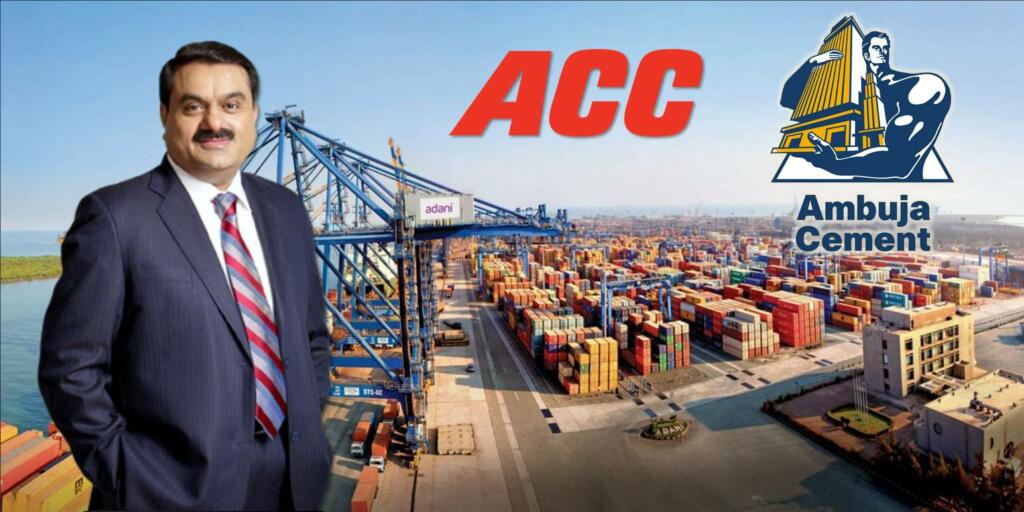Business is the art of taking a leaf out of daily life’s common sense and using its nutrients to grow a full tree. Dhirubhai Ambani’s strategy to convert high-cost debt instruments into profitable equity is one of them. Now, the world needs to have a look at Adani’s self-seller self-consumer model.
Adani group is now second-largest player in the Cement industry
Recently, Gautam Adani’s decision to acquire some big companies in India’s cement industry garnered some big headlines. The Adani group recently agreed to buy Swiss building materials maker Holcim Ltd.’s India assets Ambuja Cements and ACC Ltd for $10.5 billion (₹ 80,000 crores) in one of the largest ever acquisitions by an Indian group. The Adani family outbid the likes of JSW group and Ultratech to complete the acquisition and become the second biggest player, merely two years after foraying into the cement sector.
As per market regulator SEBI, Holcim owns 63.19 per cent in Ambuja Cement and 4.48 per cent in ACC. Ambuja Cement, in turn, owns a 50.05 per cent share of ACC. The Adani family will now hold 26 per cent of these two companies as non-promoter shareholders.
Read more: Gautam Adani comes across as a compulsive, obsessive shopaholic
Understanding Gautam Adani’s rationale
Though, Gautam Adani is a compulsive buyer, even judging the deal on Adani’s standards, the decision to become second-largest player came as a surprise for many. It did not make much sense for Adani to diversify his portfolio. Adani group is already invested in port management, electric power generation and transmission, renewable energy, mining, airport operations, natural gas, food processing and infrastructure. Prima facie, common sense suggests that the investment would only divert Adani from his core businesses.
But, there is madness and there is a method behind the madness. It’s not fair to judge the former without understanding the latter. Let’s understand Adani’s strategy for the acquisition.
Adani’s infrastructure ventures
Adani group is one of the biggest investors in India’s infrastructure growth. By the end of March this year, Adani Group had invested Rs 41,000 crore in road construction. The portfolio includes a 5,000 km road spread over 10 states. In India’s port sector, Adani is the biggest investor. At 10 ports, the Company named Adani Ports & SEZ (APSEZ) is involved in Port management, logistics and the special economic zone. In last few months, the group made massive announcements of investing Rs 10,000 crore each in ports of West Bengal and Maharashtra respectively.
Not only ports and roads, but Adani is also investing in strengthening India’s airport infrastructures. In 2020, he announced to invest Rs 35,780 crore in airport infrastructure. Additionally, Adani is also heavily invested in other urban infrastructure projects including urban houses.
Problem with cement industry in India
Apart from being progressive in nature, the single biggest link connecting aforementioned projects is the requirement of cement to get them going. New construction requires cement. But there is a big problem with cement availability in India. In spite of being second largest cement producer in the world, country lacks an adequate supply chain to distribute it in even proportion. Due to this, cement is by and large a regional commodity in India. The lack of competition among local distributors often leads to an abnormal increase in prices. At the end of fiscal year 2021, wholesale price index of Cement in India witnessed an increase of 20 percent. This is a huge problem given the fact that by preliminary estimation, India’s 2022 cement production is set to increase by 28.3 percent. Given Adani’s investment in infrastructure, the possibility of big loss was looming large.
Self-seller, self-consumer model
But, the Animal spirit in business does not listen to practical reality. It wants the problem to be solved at any cost. Adani listened to it and decided to supply cement to his own industry. By buying Ambuja and ACC, Adani decided to ‘cement’ his own infrastructure projects. Now Adani Group will produce the cement to utilise in its own infrastructure projects. Explaining the mechanism, Gautam Adani said, “On the demand side, we continue to execute on a massive number of construction activities that span every one of our infrastructure businesses. I, therefore, expect us to be one of the largest customers of our own cement business,…”
Additionally, Adani also hedged his bait on Modi government’s infrastructure push. Explaining how government projects are going to drive cement demand massively, Adani added, “The creation of 100 smart cities, 200 new airports, Housing-for-All as part of the Pradhan Mantri Awas Yojana, large-scale concrete highways and the ministry mandate that stipulates a minimum of 25% of concrete volume to be used in national highways, expressways and other centrally sponsored road projects, the rise of dedicated freight corridors – the list of possibilities that will drive cement consumption is endless.”
Backward integration is good for efficiency
Through the aforementioned deal, Adani group has ensured that it is the dominant player in the supply chain of its own infrastructure project. This strategy is called backward integration. It is when a company buys another company that supplies the products or services needed for production. Though, it does seem like it is a kind of monopoly as everything is being guided by a decision-making authority operating under a single roof. But, on the flip side, it will lead to an increase in efficiency of the cement industry.
At the end of the day, final result is what matters. Adani has a proven record of successfully running an infrastructure company. The new strategy is only going to increase India’s infrastructure growth, simultaneously expanding Adani Group’s business.
Support TFI:
Support us to strengthen the ‘Right’ ideology of cultural nationalism by purchasing best quality garments from TFI-STORE.COM
Also watch:
